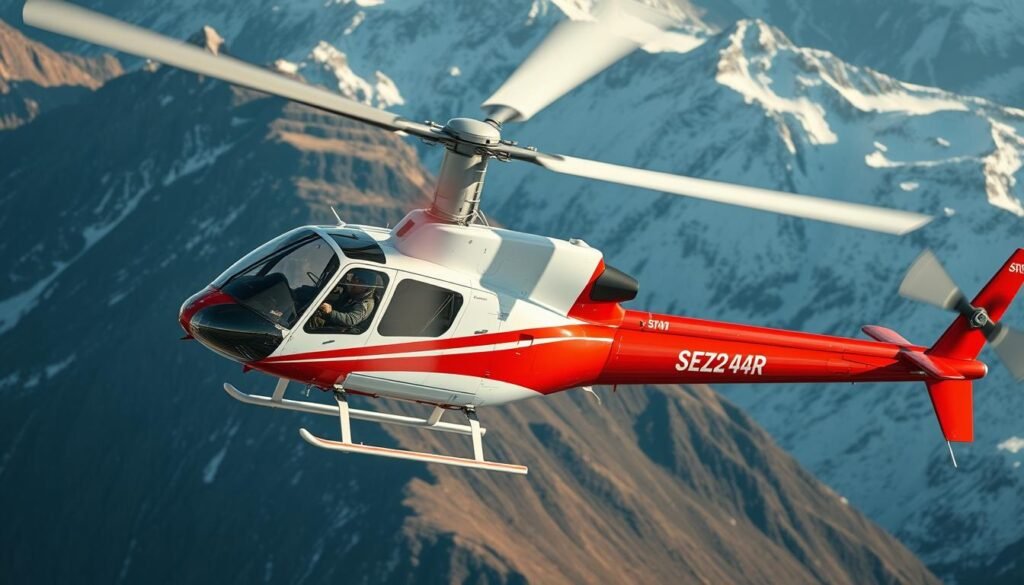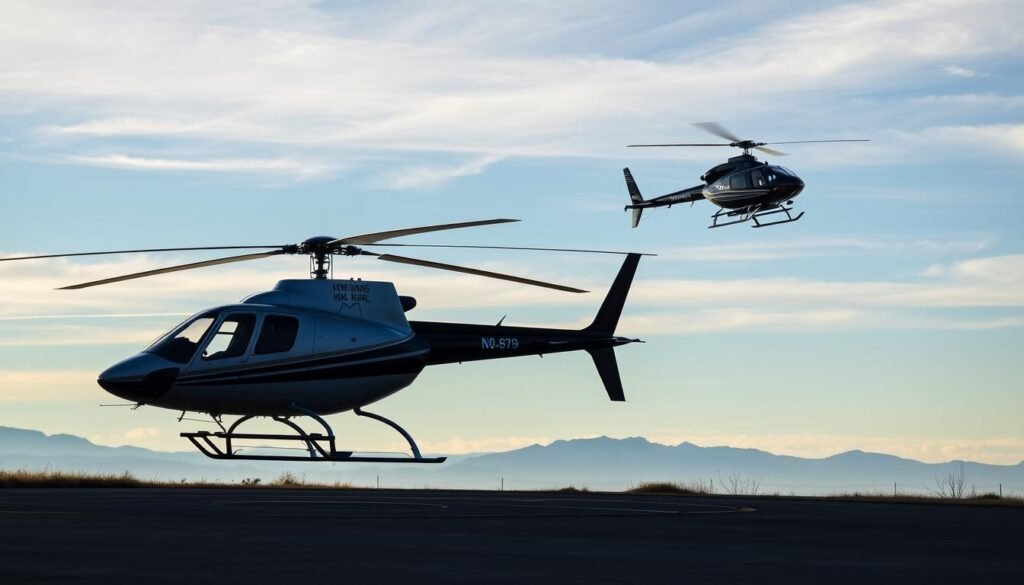They remember the first sunrise after a long night shift, the knot of fear and hope in their chest, and the quiet promise that a patient’s life might hinge on each decision. This guide speaks to that mix of duty and ambition.
The article maps a U.S.-focused budget and timeline from first lesson through professional certification. It uses real figures, like Hillsboro Heli Academy’s indicative totals: Private Pilot License (Helicopter) about $27,155; Instrument Rating about $19,180; Commercial Certificate about $25,769; CFI about $13,687; CFII about $3,945.
Readers will see how hourly rates — Robinson R22 $325/hr, R44 $557/hr, simulator $98/hr, instructors $63/hr — and fees add up. It explains why FAA minimum hours often understate real-world needs and why simulators and structured curriculum improve safety and efficiency.
For a deeper comparison of programs and prices, consult this training costs overview that complements the figures here.
Key Takeaways
- This guide gives a clear U.S. budget path from first flight lesson to employable rotorcraft pilot.
- Expect hourly rates, instructor time, exams, medicals, and admin fees to drive most of the spend.
- Simulator hours and structured curriculum can lower risk and improve cost efficiency.
- Plan for more than FAA minimum hours; real proficiency usually takes extra flight time.
- Smart financing and reputable schools reduce delays and protect safety standards.
Understanding The True Cost Of Becoming An EMS Helicopter Pilot
Estimating the full price of a rotorcraft career means looking past sticker figures and into hourly bills, school overhead, and extra proficiency hours.
What Drives Prices: Aircraft, Hours, And FAA Standards
Hourly rental rates form the largest slice. U.S. ranges often sit near $400–$600 per hour depending on make and size. Hillsboro lists an R22 at $325/hr and an R44 at $557/hr.
Each flight hour multiplies that base rate. Instructor-led dual time, ground lessons, and required solo hours all add up. FAA minima set floors, yet most students fly more hours to reach real-world proficiency.
How U.S. Training Paths Shape Your Budget
Choice of Part 61 versus Part 141, à la carte versus degree routes, affects scheduling flexibility and financing access. Simulators and instrument work reduce some aircraft time but add separate line items.
- Aircraft selection changes hourly expense and employer perception.
- School overhead—maintenance, insurance, fuel—appears in hourly charges.
- Consistent scheduling keeps skill retention high and limits repeat lessons.
Understanding all drivers helps candidates plan a realistic budget and avoid interruptions that inflate total hours and final spend.
Cost To Become An EMS Helicopter Pilot: Training, Gear & Licensing
Pricing for rotorcraft education varies by aircraft, region, and how schools count hours and extras.
Typical U.S. Price Ranges Versus School-Estimated Totals
Representative ranges span widely: PPL(H) $20,000–$60,000; IR $35,000–$50,000; CPL about $35,000; CFI $10,000–$25,000; CFII roughly $15,000.
Hillsboro Heli Academy’s averages provide a useful benchmark: PPL $27,155; IR $19,180; CPL $25,769; CFI $13,687; CFII $3,945.

Regional And School Factors That Influence Final Spend
Hourly rates matter. Typical listings show R22 at $325/hr, R44 at $557/hr, simulators around $98/hr, and instructor/ground time near $63/hr.
- Metropolitan areas often charge more because of fuel, insurance, and labor.
- Programs quoting R22 hours may look cheaper than those using R44; confirm aircraft type and included hours.
- Simulator hours reduce aircraft wear but do not replace required flight time.
- Add exam, medical, and admin fees when comparing school proposals.
Bottom line: Request an itemized quote showing aircraft type, estimated dual and solo hours, simulator allocation, instructor time, and all testing fees to forecast final spending accurately.
License-By-License Breakdown: Private, Instrument, Commercial, CFI, CFII
Breaking down each certificate helps candidates plan hours, fees, and practical expectations.
Private Pilot License (PPL‑H) Costs And Completion Realities
Typical completion aligns with Hillsboro’s ~$27,155 estimate when using R22 rates and structured ground work. Students should budget for instructor hours, school examining fees, and the FAA written fee.
Instrument Rating (IR) For Helicopter: Price And Value In Low-Visibility Ops
The IR elevates capability under instrument rules and often adds about $19,180 in program totals. Simulators at $98/hr can trim aircraft hours while improving procedural skills.
Commercial Pilot License (CPL-H): Training Time And Budget
Commercial certificate estimates near $25,769. Plan for added dual and solo hours plus DPE practical fees typically $600–$800.
Certified Flight Instructor (CFI) And CFII: Cost To Build Hours And Income
CFI programs often run close to $13,687, while CFII can be under $3,945. Becoming a flight instructor lets candidates earn while building time and refining teaching skills.
| Certificate | Hillsboro Estimate | Key Fees | Useful Rates |
|---|---|---|---|
| Private Pilot License | $27,155 | FAA written $175; school fee $500 | R22 $325/hr |
| Instrument Rating | $19,180 | Exam fees; simulator $98/hr | Instructor $63/hr |
| Commercial Pilot | $25,769 | DPE $600–$800 | R44 $557/hr |
| CFI / CFII | $13,687 / $3,945 | Checkride and school fees | Flight & ground combined |
Hourly Rates And Training Line Items That Add Up
Budget clarity begins with hourly transparency. Every candidate should map hourly charges across aircraft, simulator, instructor, and ground lessons. Small per-hour gaps compound across dozens or hundreds of hours and change final outlay.

Helicopter Rental: Robinson R22, R22 IFR, And R44 Hourly Rates
Aircraft rental is the dominant line item. Hillsboro Heli Academy lists R22 and R22 IFR at $325/hr and R44 at $557/hr. That difference in type materially shifts totals as students progress from private work to commercial maneuvers.
Simulator Time: Lower-Cost Proficiency Building
Simulators lower aircraft wear and sharpen procedures. The FRASCA TruFlite shows at about $98/hr, making it efficient for instrument work, emergency rehearsals, and checklist discipline.
Instructor And Ground School Fees
Instructor billed hours cover both airborne and ground briefings and run near $63/hr. Group ground sessions are commonly offered at about $32/hr, a cost-effective way to cover systems, weather, and navigation.
- Expect separate line items for fuel surcharges, headset rental, and checkout requirements per aircraft.
- Track hourly burn rates by phase; this helps decide when to move from R22 to R44 and how many simulator hours to schedule.
- Ask schools about fleet reliability—fewer cancellations reduce repeat flights and lower the overall hours needed.
| Item | Rate | Role |
|---|---|---|
| R22 / R22 IFR | $325/hr | Primary trainer aircraft |
| R44 | $557/hr | Advanced maneuver flight time |
| FRASCA Simulator | $98/hr | Proficiency & instrument work |
| Instructor / Ground | $63/hr / $32/hr | One-on-one and group instruction |
Exams, Medicals, And Administrative Fees To Plan For
Careful scheduling of tests, medicals, and admin steps prevents postponements and extra booking charges. Candidates should align exam dates and medical renewals with planned flight currency so eligibility is uninterrupted.

FAA Written, Oral, And Practical Test Costs
The FAA written knowledge test runs about $175 via PSI. Schools commonly add an examining coordination fee near $500 for PPL, IR, and CFI appointments.
For commercial and advanced practicals, a DPE charge typically ranges $600–$800. Students must also book the aircraft for the flight portion; that hourly rental is billed separately.
Medical Certification And Renewal Cadence
Medical certificates renew every 12, 24, or 60 months based on class and age. Aligning medical checks with the training timeline avoids lapses that block a scheduled checkride.
Applications, Registration, Deposits, And Safety Courses
Administrative line items include application fees (~$50), registration (~$100), and refundable training deposits (commonly $500). International students may see a processing fee around $300.
An optional Robinson Safety Course is valued by many operators and runs near $900. Though optional, it can improve confidence in R22/R44 operations and may influence operator hiring decisions.
| Fee Item | Typical Amount | Who Pays | Notes |
|---|---|---|---|
| FAA Written Test | $175 | Student | PSI-administered, per test |
| School Examining Fee | $500 | Student | Covers coordination for PPL/IR/CFI |
| DPE Practical | $600–$800 | Student | Commercial / CFII typical range |
| Admin & Processing | $50–$500 | Student / International | Application, registration, deposit, international fees |
Essential Gear And Study Materials For Helicopter Pilots
Students should outfit themselves early with reliable tools that simplify preflight planning and in-flight decision making.
Personal items commonly expected by schools include a quality ANR headset, an electronic flight bag, kneeboard, logbook, and core texts. Some programs bundle a kit, but many items remain student-purchased.
Headsets, EFBs, Kneeboards, And Training Materials
A good ANR headset improves communications clarity and lowers fatigue in high-vibration cabins. An EFB like an iPad running ForeFlight centralizes weather, charts, weight and balance, and performance sheets for ground and flight tasks.
- Kneeboards and structured syllabi help students track lesson objectives and progress toward checkrides.
- POHs for each aircraft type and up-to-date checklists reduce confusion when moving from R22 to R44 or IFR variants.
- Organized documents—endorsements, TSA ID, and medicals—prevent administrative delays ahead of evaluations.
| Item | Typical Note | Who Buys |
|---|---|---|
| ANR Headset | Reduces fatigue; improves comms | Student |
| EFB (iPad + App) | Charts, WX, performance | Student / School |
| Logbook & Texts | Track hours and study | Student |
Bottom line: Investing in reliable items early improves learning efficiency and builds an experience base that supports private pilot work, advanced ratings, and later instructor roles.
Choosing A Training Path: À La Carte Certificates Versus Degree Programs
Students must weigh flexibility against structure when selecting a pathway. The decision affects funding options, pace, and ultimate career readiness. Choosing a route early helps shape scheduling and aircraft choices.

Direct Pathway To Professional Pilot Ratings
The direct route focuses on sequential certificates and ratings: PPL(H), IR, CPL(H), CFI, CFII. It gives students control over pace, aircraft mix, and cash flow.
Advantages: lower overhead, modular scheduling, and faster accumulation of flight hours when concentrated. Applicants often select this path when they aim to enter the workforce quickly.
University-Affiliated Programs And Total Cost Considerations
University-affiliated programs bundle academics with flight syllabi. They can exceed $180,000 but open access to loans, grants, and scholarships.
Trade-offs: higher total spend but predictable scheduling, academic support, and degree credentials that aid later leadership roles.
| Feature | Direct (À La Carte) | University-Affiliated |
|---|---|---|
| Funding Options | Limited; mostly pay-as-you-go | Loans, grants, scholarships available |
| Flexibility | High — choose aircraft and pace | Lower — academic calendar driven |
| Average Total Outlay | Variable; generally lower | Often exceeds $180,000 |
| Career Benefits | Faster hour build for flight roles | Degree helps management or training leadership |
- Evaluate any school by instructor experience, fleet maintenance, dispatch reliability, and pass rates.
- Compare total hours, aircraft mix (R22/R44), simulator access, and progression milestones.
- Request itemized proposals that list aircraft hours, instructor/ground hours, and all exam and admin fees.
- Consider alumni networks and hiring pipelines; they often turn training investment into quicker career traction.
For guidance on choosing a reputable academy and comparing programs, review this how-to guide for selecting a helicopter.
Funding Your Training: Loans, Scholarships, VA Benefits, And Pay-As-You-Go
Many students mix loans, scholarships, and pay-as-you-go billing to sustain progress. That blended approach helps preserve lesson cadence and reduces the risk of gaps that erode skills.
Private Career Loans, Parent/Sponsor Options, And Title IV Advantages
Private career loans such as College Ave Career Loan and Parent/Sponsor Loan can cover most tuition and flight hours. Pay-as-you-go billing keeps upfront needs modest and helps a student manage cash flow while flying regularly.
Title IV eligibility allows 529 plan use and may yield tax benefits when expenses qualify. Applicants should keep detailed records for any taxes or deductions claimed.
Scholarships And Industry Organizations To Target
Scholarships from schools and groups like FAA listings, Whirly-Girls, and Women in Aviation International offset milestones such as instrument or instructor certificates. Other lenders—AOPA Finance and Sallie Mae—may fill gaps where grants do not.
GI Bill/VA Benefits And School Eligibility
Veterans should confirm school approval and align enrollment with Post-9/11 GI Bill rules. Proper timing maximizes benefit use and supports a steady path toward a professional pilot career.
| Option | Who It Helps | Notes |
|---|---|---|
| Private Career Loan | Students | Large coverage; repay after training |
| Parent/Sponsor Loan | Student & Family | Flexible repayment; lower rates possible |
| Pay-As-You-Go | Paying Students | Bill after each lesson; reduces upfront burden |
| Scholarships / Grants | Students | Target milestone awards; apply early |
| VA / GI Bill | Veterans | Must use approved programs; can cover large share |
Bottom line: A blended plan—small loans, targeted scholarships, and pay-as-you-go—creates resilience and keeps students moving toward the first job. For practical payment ideas, see this ways to pay for flight programs and review academy options at top leading academies.
Conclusion
Careful planning and disciplined hour building convert complex requirements into a predictable path for aspiring aviators. A realistic budget includes PPL(H) ~$27,155, IR ~$19,180, CPL(H) ~$25,769, CFI ~$13,687, and CFII ~$3,945 from Hillsboro estimates.
Hourly rates—R22 $325/hr, R44 $557/hr, simulator $98/hr, instructor/ground $63/hr—plus FAA tests (written $175; examining fee $500; DPE $600–$800) shape the timeline. Compare school proposals by aircraft type, average hours, instructor availability, and checkride results to protect safety and schedule.
Mixing loans, scholarships, VA benefits, and pay-as-you-go keeps lessons steady. With steady progress, targeted instruction, and focus on procedures, becoming a commercial helicopter pilot and certified flight instructor is an attainable, meaningful career path.



